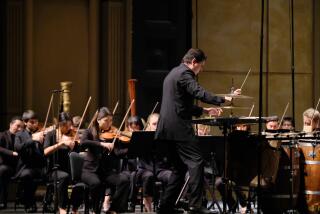Big Bands’ Fate
- Share via
It is about time someone of Don Heckman’s stature wrote of our sad musical state of affairs (“The Big-Band Survival Kit,” June 16). Heckman lists four reasons for the demise of big bands. I would like to add two:
American Federation of Musicians President James Caesar Petrillo called for a musicians’ strike that lasted more than a year right at the height of big bands’ popularity (August 1942 to November 1943). No big band records were made except those recorded and sent to U.S. servicemen overseas (V Discs). There was another strike in 1948. After that, the music changed slowly at first, with Stan Kenton playing bebop. The style stopped people from dancing, and dancing was part of the reason for the existence of big bands. All the bands were dance bands (except Ellington)--Isham Jones, Paul Whiteman, Fletcher Henderson, Glen Gray. Each had its own sound and, hot or sweet, the kids danced.
Almost all of the big band musicians started out playing in their colleges, and maybe if the musicians union could back off, the kids would be allowed to form a band and play in a local hotel for a modest salary and some big bands may start to swing.
Let’s face it. We have thrown away the best form of popular music this country has ever known, all for the likes of a bunch of “cretins” (Sinatra’s term) who have polluted popular music with rock ‘n’ roll.
MARTY CAPUNE
Newport Beach
*
Although perhaps well meaning, Heckman’s article about the state of big bands as well as his subsequent reviews of a number of large ensemble discs fail to even mention the stellar work of valve trombonist-composer-arranger Bob Brookmeyer and his New Art Orchestra. “Celebration,” the Brookmeyer ensemble’s first CD, received the U.K. equivalent of a Grammy several years ago. The group’s new CD, “Waltzing With Zoe,” received four stars recently in these very pages by critic Howard Reich.
In spite of such a glaring omission by Heckman, Brookmeyer’s influence as one of the giants of large-ensemble jazz continues to be far-reaching. Sure, you can’t name everyone, but at least include those who have helped to keep large-ensemble jazz alive despite all odds, including corporate ignorance and critical biases.
MICHAEL STEPHANS
Altadena
More to Read
The biggest entertainment stories
Get our big stories about Hollywood, film, television, music, arts, culture and more right in your inbox as soon as they publish.
You may occasionally receive promotional content from the Los Angeles Times.









